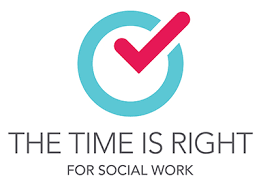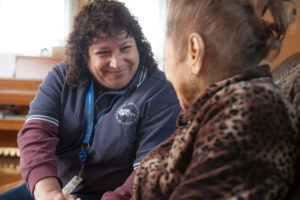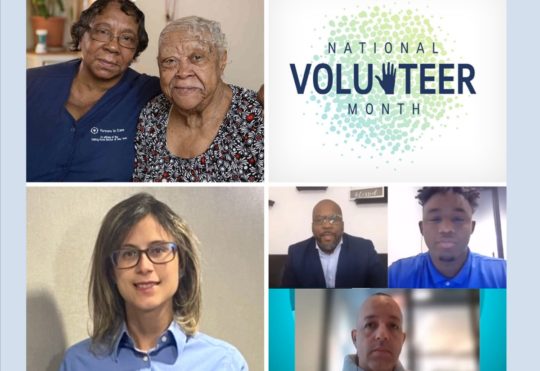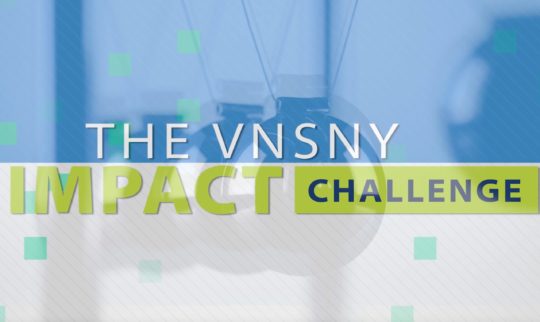9 Things You May Be Surprised to Know about Social Work and Our More Than 445 Social Work Team Members
 March is National Social Work Month—a fitting celebration of the vital work that our social work team members do all year long. To celebrate, here are 9 things about social work and VNSNY’s social work team members that may surprise you.
March is National Social Work Month—a fitting celebration of the vital work that our social work team members do all year long. To celebrate, here are 9 things about social work and VNSNY’s social work team members that may surprise you.
1) Social work is one of the fastest growing careers in the United States.
 According to the U.S Department of Labor Bureau of Labor Statistics, the need for social workers is expected to grow significantly over the next decade, especially in the areas of gerontology, home health care, substance use, private social service agencies, and school social work. There were more than 715,000 social work jobs in 2020, and the profession is expected to grow by 12 percent by 2030.
According to the U.S Department of Labor Bureau of Labor Statistics, the need for social workers is expected to grow significantly over the next decade, especially in the areas of gerontology, home health care, substance use, private social service agencies, and school social work. There were more than 715,000 social work jobs in 2020, and the profession is expected to grow by 12 percent by 2030.
2) Social workers play an overarching role in their clients’ lives.
 One common misconception about social workers is that their role is limited to connecting people with community resources in order to meet their most basic, concrete needs. “While that’s an important part of our role, we also provide counseling, education, advocacy and care coordination, says Jeri Goodman, Associate Director for Social Work Services for VNSNY Home Care.
One common misconception about social workers is that their role is limited to connecting people with community resources in order to meet their most basic, concrete needs. “While that’s an important part of our role, we also provide counseling, education, advocacy and care coordination, says Jeri Goodman, Associate Director for Social Work Services for VNSNY Home Care.
 Earlier in her career when she worked as a care manager providing direct services, recalls Tara Noto, Vice President, Behavioral Health Programs, she helped clients navigate paperwork, get organized, learn how to email, and even acquire library cards. She’s also assisted them in obtaining calendars, alarm clocks, watches and phones to help them keep their appointments. “We take so much for granted—living in safe homes where we can receive mail and store our documents. Many of our clients in Behavioral Health don’t have those advantages, and the smallest thing—like assistance in getting an ID so they can access other services—can make a dramatic difference in their lives,” says Tara. “Listening to them and hearing their needs and struggles also helps us to be better, because it helps us identify challenges in the system that need more advocacy, more support, more resources, and more attention.”
Earlier in her career when she worked as a care manager providing direct services, recalls Tara Noto, Vice President, Behavioral Health Programs, she helped clients navigate paperwork, get organized, learn how to email, and even acquire library cards. She’s also assisted them in obtaining calendars, alarm clocks, watches and phones to help them keep their appointments. “We take so much for granted—living in safe homes where we can receive mail and store our documents. Many of our clients in Behavioral Health don’t have those advantages, and the smallest thing—like assistance in getting an ID so they can access other services—can make a dramatic difference in their lives,” says Tara. “Listening to them and hearing their needs and struggles also helps us to be better, because it helps us identify challenges in the system that need more advocacy, more support, more resources, and more attention.”
3) Counseling is another big component of social work.
According to government sources, more than 60 percent of mental health treatment is delivered by social workers. At VNSNY, many of our social workers are part of our behavioral health teams, where they either provide counseling directly, or connect clients with mental health or substance use treatment.
4) Almost 70 social work team members work in our Hospice.
 In addition to the 63 full-time and 6 per diem social workers and other social services employees who work with hospice patients and their families, 300 social work and social services team members work in Behavioral Health, 26 work in Home Care (CHHA), 6 work in the Care Management Organization (CMO), and 37 work in our newly launched Management Services Organization (MSO).
In addition to the 63 full-time and 6 per diem social workers and other social services employees who work with hospice patients and their families, 300 social work and social services team members work in Behavioral Health, 26 work in Home Care (CHHA), 6 work in the Care Management Organization (CMO), and 37 work in our newly launched Management Services Organization (MSO).
5) Not all VNSNY social work team members work in the field.
There are social workers in a variety of roles across the organization. They range from social workers doing direct care out in the community in people’s homes to the care coordinators and care managers in the CMO and the health plans.
 Michael Fagan, Director of Behavioral Health at CHOICE Health Plans, draws on his social work background even though he serves in a purely administrative role. “I work in a team of three, supervising Beacon Health Options,” he says. “We basically ensure that Beacon is doing the utilization review, assigning care-management cases, and reporting the claims and other metrics. I’m not diagnosing or treating anymore in my current position, but I use my skills and experience from my past social work field experience every day.”
Michael Fagan, Director of Behavioral Health at CHOICE Health Plans, draws on his social work background even though he serves in a purely administrative role. “I work in a team of three, supervising Beacon Health Options,” he says. “We basically ensure that Beacon is doing the utilization review, assigning care-management cases, and reporting the claims and other metrics. I’m not diagnosing or treating anymore in my current position, but I use my skills and experience from my past social work field experience every day.”
6) Virtual social work visits are letting team members reach more clients.
 During the COVID-19 pandemic, VNSNY social work team members demonstrated great agility by finding innovative solutions when clients couldn’t be seen face to face (or requested not to be seen, as some clients worried about having clinicians in their home, especially when there was very limited PPE available early on). These included offering the option of virtual encounters, which have turned out to be very effective. “With social work, the expectation historically has been that the visits had to be in person,” says Tara. “One of the remarkable things that happened when we went virtual was our ability to reach more people. For instance, we have a children’s mental health clinic in the Bronx, and our show rate increased dramatically when we started to use telehealth which includes video and phone visits.” Even though the clinic is now open again for in-person care, the virtual approach remains a good option for parents with childcare or transportation issues. “It’s given us much more flexibility, and our clients now have more choices in accessing care,” Tara adds.
During the COVID-19 pandemic, VNSNY social work team members demonstrated great agility by finding innovative solutions when clients couldn’t be seen face to face (or requested not to be seen, as some clients worried about having clinicians in their home, especially when there was very limited PPE available early on). These included offering the option of virtual encounters, which have turned out to be very effective. “With social work, the expectation historically has been that the visits had to be in person,” says Tara. “One of the remarkable things that happened when we went virtual was our ability to reach more people. For instance, we have a children’s mental health clinic in the Bronx, and our show rate increased dramatically when we started to use telehealth which includes video and phone visits.” Even though the clinic is now open again for in-person care, the virtual approach remains a good option for parents with childcare or transportation issues. “It’s given us much more flexibility, and our clients now have more choices in accessing care,” Tara adds.
6) There’s a new social work resource group at VNSNY.
The Social Work and Behavioral Health Community of Practice is a newly formed group of professionals from across the organization. As the name suggests, the group includes not only social work but social services and behavioral health, in keeping with VNSNY’s emphasis on integration, connection, coordination and growth. “The work someone is doing might look a little different, depending on their program and role, but we all have shared professional concerns and interests, as well as a shared commitment to the organization’s mission of serving the healthcare needs of New Yorkers in their homes and communities,” says Jeri.
7) VNSNY Home Care social workers are a major source of referrals to VNSNY Behavioral Health.
Over the past year, social workers with VNSNY Home Care made more than 300 referrals to VNSNY’s Behavioral Health programs—a considerable jump from 70 the year before. The increase came about when Home Care social workers were educated about services available through Behavioral Health and oriented to a new streamlined referral process. This jump-started internal referrals, enabling patients to be quickly connected to the behavioral health supports they need. “It’s yet another great example of collaboration and building internal relationships, and that’s a great shout-out to both teams,” Jeri notes.
8) Jim Rolla, Senior VP, Partners in Care, just got his LMSW degree!
 Jim had wanted to be a social worker since high school. He put those yearnings on hold as he pursued a different career path, but they were vividly revived when his mother had a terminal illness. “Of all the professionals I had to interact with at that time, the social workers were the ones who made the greatest impact on me—from end-of-life planning and quality of life to helping arrange services for my father, who needed support,” he says. “That experience was a real reminder of my passion for social work and why I found it so valuable.” When Jim came on board at VNSNY, it was with the stipulation that he be allowed to complete his degree. Not only was he encouraged, but he even did his field work at VNSNY, with Jeri Goodman as his field instructor. “I learned a lot about myself while I getting my social work degree,” says Jim. “I gained the ability to view my decision-making through multiple different lenses and standpoints, which I think has made me a better leader. I’m extremely proud of my degree.”
Jim had wanted to be a social worker since high school. He put those yearnings on hold as he pursued a different career path, but they were vividly revived when his mother had a terminal illness. “Of all the professionals I had to interact with at that time, the social workers were the ones who made the greatest impact on me—from end-of-life planning and quality of life to helping arrange services for my father, who needed support,” he says. “That experience was a real reminder of my passion for social work and why I found it so valuable.” When Jim came on board at VNSNY, it was with the stipulation that he be allowed to complete his degree. Not only was he encouraged, but he even did his field work at VNSNY, with Jeri Goodman as his field instructor. “I learned a lot about myself while I getting my social work degree,” says Jim. “I gained the ability to view my decision-making through multiple different lenses and standpoints, which I think has made me a better leader. I’m extremely proud of my degree.”

